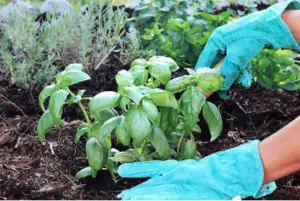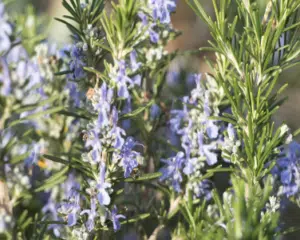HALF PRICE SALE ENDS AT MIDNIGHT – ORDER NOW!
***TODAY ONLY – GET AN EXTRA 10% OFF SALE PRICES WITH CODE FLASH10***
Menu
HALF PRICE SALE ENDS AT MIDNIGHT – ORDER NOW!
***TODAY ONLY – GET AN EXTRA 10% OFF SALE PRICES WITH CODE FLASH10***
 https://www.hopesgrovenurseries.co.uk/wp-content/uploads/2017/09/rosemary-750x237.jpg
https://www.hopesgrovenurseries.co.uk/wp-content/uploads/2017/09/rosemary-750x237.jpg
Growing your own herbs from scratch and then using them in your cooking is immensely satisfying. Each one of these five herbs can turn a bland dish into something incredible; what’s more, they’re all rich in nutritional benefits and they’ll give your kitchen and garden a wonderful smell!

Basil is widely used throughout southern Europe, particularly the Mediterranean, and in many parts of Asia. The variety called holy basil is an essential ingredient of an authentic Thai curry. In Mediterranean regions, basil and tomato is a classic combination. Basil provides us with healthy doses of vitamins A, K, and C, as well as magnesium, iron, potassium, and calcium. To grow basil from seed, sow indoors in the early spring in rich, moist, well-drained soil, and then move outdoors to a sheltered position in full sun, as basil is very sensitive to the cold.

Coriander is the UK’s most sold kitchen herb. It is high in antioxidants, aids digestion and relieves inflammation. Its powerful flavour makes it an excellent seasoning for meats and salsas. You can grow coriander by sowing seeds outdoors during spring and summer in full sun, as seeds will grow quicker, but for leaf production, partial shade is more productive.

Oregano is an important herb in Italian, Greek and Mexican cooking, and is often used dried rather than fresh in strongly flavoured dishes. To grow oregano from seed, sow indoors until early summer, or until all danger of frost has passed in well-drained soil, then plant in a sunny, sheltered spot in well-drained soil. During cold months, oregano should be mulched or covered with a cold frame to protect roots from freezing.

Parsley is one of the most popular herbs in British cooking and is also commonly found in European and Middle Eastern cuisines. It is often used in salads, soups, stews, and sauces, and is an essential ingredient in many dishes, including salsa verde and tabbouleh. Parsley is a powerful antioxidant and anti-inflammatory, which makes it great for detoxification and digestion. To grow parsley from seed, sow outdoors from early spring to the start of summer in well-drained, rich soil in partial shade. To promote thicker foliage, cut parsley down to stems in early autumn.

Fresh or dried leaves of rosemary can be used to flavour meat, soups and vegetable dishes, while sprigs steeped in olive oil give it a distinctive flavour. Rosemary is best started in the spring from ready-grown plants and placed in a sunny, sheltered position in well-drained soil. Plants are fairly drought-tolerant, but need regular watering during dry summers, especially if they are grown in containers.
These herbs don’t require you to invest large amounts of effort to keep them healthy, and they’ll reward you time and again with incredible flavours!
Many of our customers buy topiary plants (and hedging plants) to grow in containers, one frequently asked question is how large does the pot that I plant them into need to be?
Expert horticultural advice on the merits and pitfalls of planting bare root yews, and how to get the best from them.
Pleached trees are a garden-design favourite, because they provide an instant leafy screen that looks stylish as soon as it’s planted. They offer privacy for you and they help to muffle noise and that’s becoming more important in our busy world. They provide a living screen that’s far more eco-friendly than a stark wooden fence…